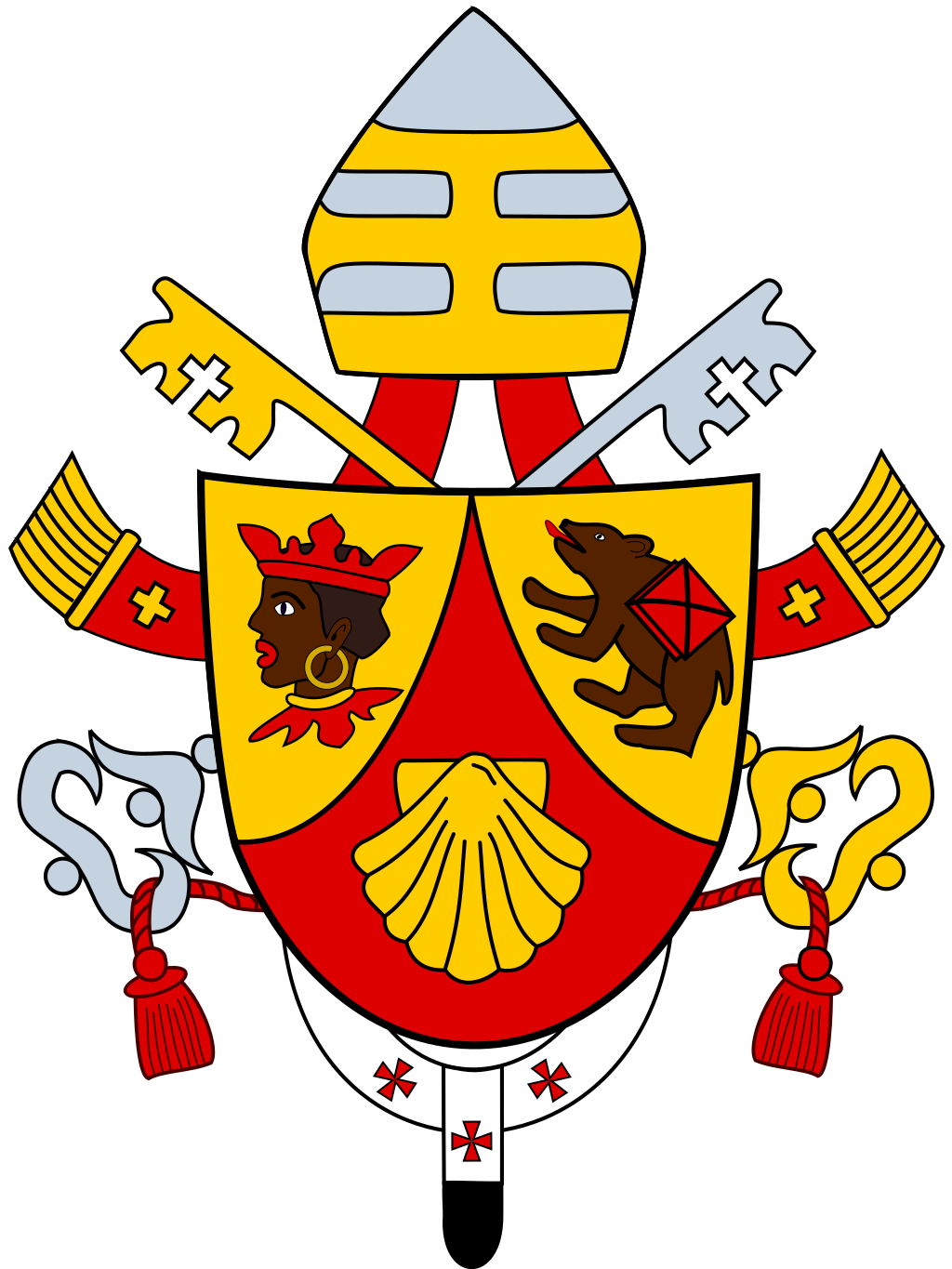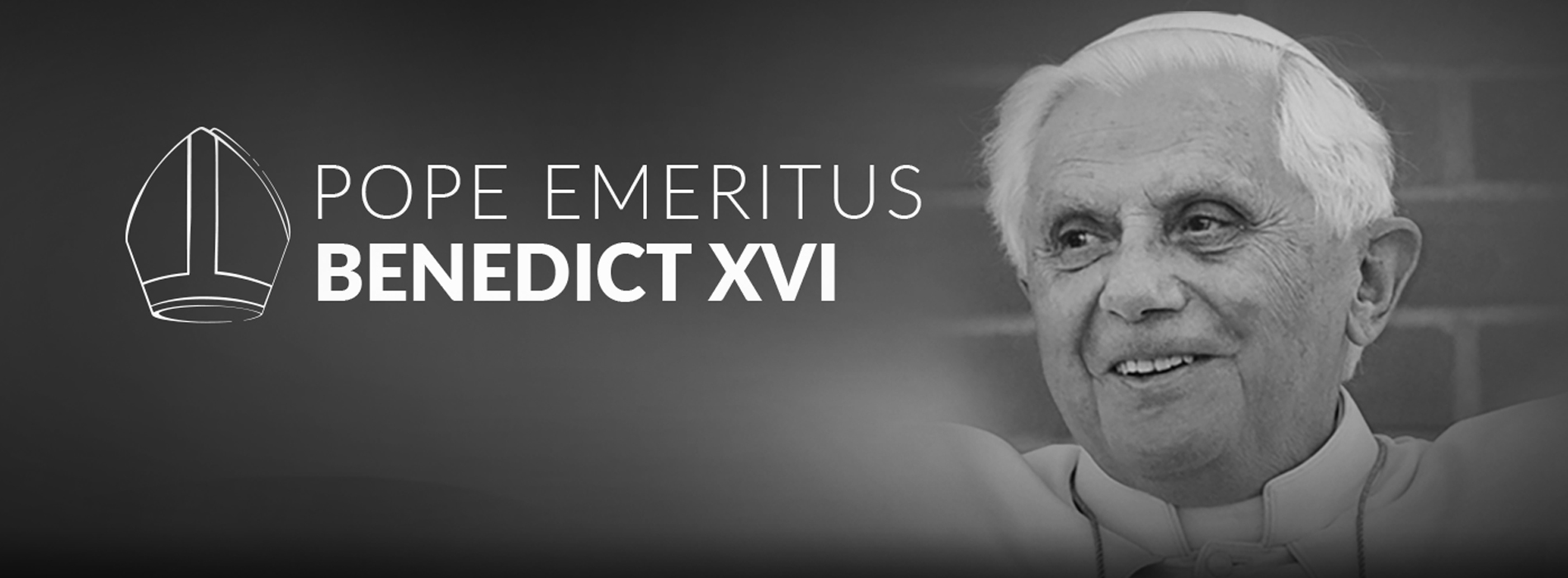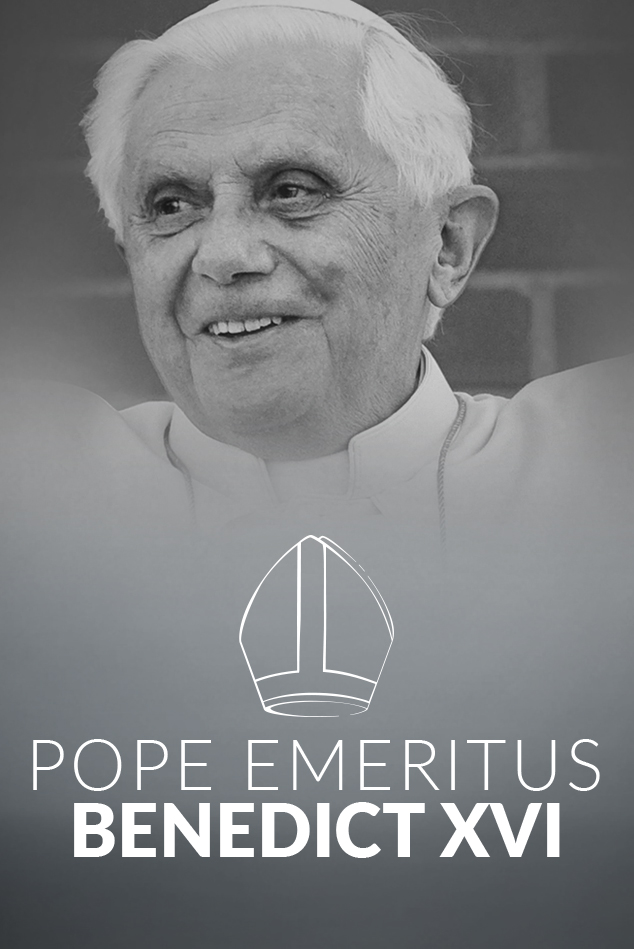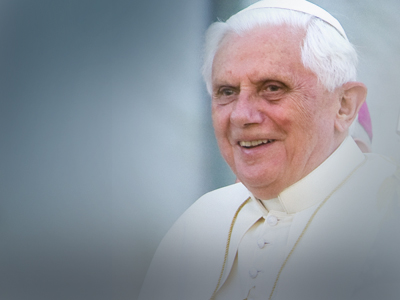The coat of arms of Pope Benedict XVI incorporates both papal elements, as well as the elements of the coat of arms he bore as Archbishop of München (Munich) and Freising, and as the Prefect of the Congregation for the Doctrine of the Faith.

The miter replaces the "beehive" tiara familiar from former papal coats of arms. Pope Paul VI dropped the ceremonial use of the tiara, although he, and his immediate successors John Paul I and John Paul II, retained it in their coats of arms. Benedict XVI has replaced it with the miter, on which is emblazoned three gold bands representing "order, jurisdiction and magisterium." These are the symbolic equivalents of the three layers of the tiara. They are connected into a unity by the vertical gold strip, representing the unity of these three kinds of authority in the person of the Supreme Pontiff.
The use of the white pallium with red crosses draped below the shield is a new addition to papal coats of arms. It represents episcopal authority, the special kind of jurisdiction that is reserved to metropolitan archbishops in their province and to the pope universally in the Church, what is called the plenitudo pontificalis officii (i.e. the plenitude of pontifical office). The style of pallium shown on the coat of arms, with either red or black crosses on a narrow band of wool, is what is commonly known from the second millennium. At his inaugural Mass, Pope Benedict wore an older style of pallium, broad with red crosses, and hanging down from the left shoulder rather than in the middle. This style is more typical of the first millennium, and similar to the omophorion representing episcopal authority in the Eastern Church.
The two crossed keys symbolize the powers Christ gave to the Apostle Peter and to his successors.
I will give you the keys to the kingdom of heaven. Whatever you bind on earth shall be bound in heaven; and whatever you loose on earth shall be loosed in heaven." (Matthew 16:19)
The gold key represents the power to bind in heaven and the silver key spiritual authority on earth. The two keys are united by the cord, again indicating their essential unity in Peter and his successors.
According to the website of his former Archdiocese:
"The shield, which is divided into three sections, displays the “Moor of Freising." The Moor’s head, facing left and typically crowned, appeared on the coat of arms of the old principality of Freising as early as 1316, during the reign of the Bishop of Freising, Prince Konrad III, and it remained almost unchanged until the “secularization” of the Church’s estates in that region in 1802-1803. Ever since that time the archbishops of Munich and Freising have included the Caput Aethiopum, the head of an Ethiopian, in their episcopal coat of arms."
Also present on the coat of arms is a bear with a pack-saddle, the so-called “Bear of Corbinian." The saintly Bishop Corbinian preached the Christian faith in the Duchy of Bavaria in the 8th century and is considered the spiritual father and patron of the archdiocese. A legend states that he traveled to Rome with a bear as his pack-animal, after having commanded it to do so. Once he arrived, he released the bear from his service, and it returned to Bavaria. The implication is that "Christianity tamed and domesticated the ferocity of paganism and thus laid the foundations for a great civilization in the Duchy of Bavaria." At the same time, Corbinian’s Bear, as God’s beast of burden, symbolizes the burden of office.
The symbolism of the shell is multiple. St. Augustine, Bishop and Doctor of the Church (354-430 AD), was once walking along the seashore, meditating on the unfathomable mystery of the Holy Trinity. A boy was using a shell to pour seawater into a little hole. When Augustine asked him what he was doing, he replied, “I am emptying the sea into this hole.” Thus did Augustine understand that man would never penetrate to the depths of the mystery of God. Fr. Joseph Ratzinger, in 1953, wrote his doctoral dissertation on “The People of God and the House of God in Augustine’s Teaching about the Church," and therefore has a personal connection with the thought of this great Doctor of the Church.
The shell also stands for pilgrimage, for “Jacob’s staff,” a pilgrim’s staff topped with a scallop shell. In Church art it is a symbol of the apostle James the Great, and his sanctuary at Santiago de Compostela in Spain, perhaps the principal place of pilgrimage during the middle ages. This symbol alludes, as well, to “the pilgrim people of God,” a title for the Church which Joseph Ratzinger championed at the Second Vatican Council as peritus (theological adviser) to Cardinals Frings of Köln (Cologne). When he became Archbishop he took the shell in his coat of arms. It is also found in the insignia of the Schottenkloster in Regensburg, where the major seminary of that diocese is located, a place where Benedict XVI taught as a professor of theology.
We do not yet know what the motto of Pope Benedict XVI will be. However, his episcopal motto was "cooperators veritatis" (collaborators of the truth).
Founder of western monasticism, born at Nursia, c. 480; died at Monte Cassino, 543. The only authentic life of Benedict of Nursia is that contained in the second book of St. Gregory's "Dialogues". It is rather a character sketch than a biography and consists, for the most part, of a number of miraculous incidents, which, although they illustrate the life of the saint, give little help towards a chronological account of his career. St. Gregory's authorities for all that he relates were the saint's own disciples, viz. Constantinus, who succeeded him as Abbot of Monte Cassino; and Honoratus, who was Abbot of Subiaco when St. Gregory wrote his Dialogues.
Benedict was the son of a Roman noble of Nursia, a small town near Spoleto, and a tradition, which St. Bede accepts, makes him a twin with his sister Scholastica. His boyhood was spent in Rome, where he lived with his parents and attended the schools until he had reached his higher studies. Then "giving over his books, and forsaking his father's house and wealth, with a mind only to serve God, he sought for some place where he might attain to the desire of his holy purpose; and in this sort he departed [from Rome], instructed with learned ignorance and furnished with unlearned wisdom" (Dial. St. Greg., II, Introd. in Migne, P.L. LXVI). There is much difference of opinion as to Benedict's age at the time. It has been very generally stated as fourteen, but a careful examination of St. Gregory's narrative makes it impossible to suppose him younger than nineteen or twenty. He was old enough to be in the midst of his literary studies, to understand the real meaning and worth of the dissolute and licentious lives of his companions, and to have been deeply affected himself by the love of a woman (Ibid. II, 2). He was capable of weighing all these things in comparison with the life taught in the Gospels, and chose the latter, He was at the beginning of life, and he had at his disposal the means to a career as a Roman noble; clearly he was not a child, As St. Gregory expresses it, "he was in the world and was free to enjoy the advantages which the world offers, but drew back his foot which he had, as it were, already set forth in the world" (ibid., Introd.). If we accept the date 480 for his birth, we may fix the date of his abandoning the schools and quitting home at about A.D. 500.
Giacomo della Chiesa was born, 21 November 1854, to a noble family in Pegli, Italy. He studied law at the Royal University of Genoa and theology at Rome's Gregorian University. He was ordained to the priesthood in 1878, and earned a doctorate in sacred theology in 1879. Giacomo entered the papal diplomatic service in 1882, serving as secretary to the nuncio to Spain until 1887, and as secretary to the Vatican Secretary of State until 1901, when he was made undersecretary.
In 1907, he was ordained Archbishop of Bologna, and in May 1914 he was made a Cardinal, just three months before the death of Pius X and the beginning of World War I. He was elected to succeed Pius X, probably because of his diplomatic experience. As father to all Catholics, Benedict XV favored neither side in the war. But his policy of neutrality was misinterpreted by both sides, each regarding him as siding with the other. He pressed for a Christmas truce in 1914 to ward off the “suicide of Europe,” but was ignored. In 1917, he tried to broker a peace plan, but his efforts were unsuccessful. He was able, however, to arrange the exchange of disabled prisoners through neutral countries, and to have the sick and wounded sent to neutral countries for treatment and recuperation. Through his intercession, deported Belgians were allowed to return home, and he donated money to relieve those suffering the effects of the war throughout Europe. After the war, in 1919, he asked for a Vatican role in the Paris Peace Conference, but was turned down. He pleaded with the victorious Allies to lift the blockade against Germany, because of the suffering it caused to women and children, and he took up a Church-wide collection to buy food. For human solidarity, he favored the founding of the League of Nations, though the Vatican itself was excluded from membership.
Among his other actions as Pope, Benedict XV promulgated what was then the first unified Code of Canon Law in 1917, though he gave the credit to Pius X, his predecessor. He tried to improve relations with the anticlerical Republican government of France. And he emphasized the training of native priests in the mission territories of the Third World. He was friendly toward the Orthodox Churches, founding the Oriental Institute and the Congregation for Eastern Rites. He paved the way to two future pontificates, recognizing the abilities of Achille Ratti (Pius XI), whom he sent as his representative to Poland, and then promoted to Archbishop of Milan, and of Eugenio Pacelli (Pius XII), whom he put in charge of the prisoner-of-war work at the Vatican, and then sent as nuncio to Munich. In 1920 he canonized three Saints, Gabriel of the Sorrowful Mother, Joan of Arc, and Margaret Mary Alacoque.
Pope Benedict XV died of influenza, January 22, 1922. Among his last words were "We offer our life to God on behalf of the peace of the World.




